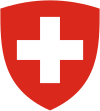1917 Swiss federal election
| This article is part of a series on the |
 |
|---|
|
|

Federal elections were held in Switzerland on 28 October 1917. The Free Democratic Party retained its majority in the National Council.[1] They were the last elections held under the majoritarian system; following a referendum in 1918 in which two-thirds of voters voted for the introduction of proportional representation, the electoral system was changed and early elections held in 1919.
Electoral system
The 189 members of the National Council were elected in 49 single- and multi-member constituencies using a three-round system. Candidates had to receive a majority in the first or second round to be elected; if it went to a third round, only a plurality was required. Voters could cast as many votes as there were seats in their constituency.[2] There was one seat for every 20,000 citizens, with seats allocated to cantons in proportion to their population.[2]
Results
Voter turnout was highest in Schaffhausen (where voting was compulsory) at 86.8% and lowest in Uri at 23.4%.
| Party | Votes | % | Seats | +/– |
|---|---|---|---|---|
| Free Democratic Party | 210,323 | 40.8 | 103 | –9 |
| Social Democratic Party | 158,450 | 30.8 | 20 | +2 |
| Conservative People's Party | 84,784 | 16.4 | 42 | +5 |
| Liberal Democratic Party | 25,188 | 4.9 | 12 | –4 |
| Democratic Group | 16,818 | 3.3 | 7 | +3 |
| Party of Farmers, Traders and Independents | 19,459 | 3.8 | 4 | +3 |
| Other parties | 1 | +1 | ||
| Invalid/blank votes | 32,630 | – | – | – |
| Total | 547,652 | 100 | 189 | 0 |
| Registered voters/turnout | 915,552 | 59.8 | – | – |
| Source: Mackie & Rose,[3] BFS (seats) | ||||
References
- ^ Elections to the National Council 1848–1917: Distribution of seats by party or political orientation Archived 2015-09-23 at the Wayback Machine BFS
- ^ a b Dieter Nohlen & Philip Stöver (2010) Elections in Europe: A data handbook, p1886 ISBN 9783832956097
- ^ Thomas T Mackie & Richard Rose (1991) The International Almanac of Electoral History, Macmillan
